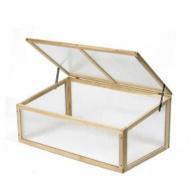A Cold Frame Is The Ideal Way To Start Off Seedlings And
Young Plants
The main advantage of a cold frame is that it enables you to raise a large variety of crops from seed right through to maturity, making it a viable proposition to have home grown vegetables in advance of their normal growing season, when shop bought ones are at their most expensive.
A coldframe creates a small microclimate that provides shelter from the wind and cold enabling you to start your plants off much earlier in the spring, and to carry on longer into the fall and winter months.
Traditional cold frames are made from wood with a glass window, and stand between 12" to 24" tall.

The top is usually hinged for easy access and sloped downwards towards the sun to capture the maximum amount of light, and to allow rainwater to drain off.
An alternative to wood is steel or aluminum, these tend to be a little less expensive then their wooden counterparts.
They're lightweight, practically maintenance free and routinely glazed all the way to the ground, which increases the amount of light considerably.
Having said that, they're not as good at storing heat overnight as wooden ones are, thereby shortening the growing season somewhat.
Exaco Trading Juwel Double Cold Frame...
These Frames are reckoned to be the finest in european design. They are weather resistant with 4mm Polycarbonate Double Skin Panes and a Sturdy Aluminum Frame.
Easy to Assemble with Easy-Fix-Click-System and Saddle Bag Design. Two Roof Windows, Each Has a Height Adjusters and Has a Child Safe Design with Rounded Edges. Includes 4 Brackets to Hold Windows Open, Adjustable, and Windows Down Against Wind and 6 Ground Stakes.
Cold Frame On Amazon...
Build Your Own...
If you like a little diy it's pretty easy to knock one together with just a couple of basic tools, and you may find that you have all you need already in your shed or garage.
I actually put one together from left over cuttings of pvc from a conservatory.
However, if you would like something a little more professional you could always invest in a small booklet such as the one here from Charles Siegchrist who is a contributor for Storey Books. I only consists of thirty two pages, and is really easy to understand.
Here's a short video that may give you a few ideas...
What's More...
You can grow virtually all the crops that you would normally have at your dinner table including, garlic, lettuce, parsley, salad onions, cabbage, spinach, beetroot, radishes and turnips and so on.
Depending on the size of your family and the amount of vegetables you require you could fill the entire frame with just one crop, but with a little planning you could grow a mixture of crops so they mature in rotation, which means that you'll get a wide selection of vegetables all through the year.
Have You Built Your Own Cold Frame?
If so let us know how you did it.
Gardening Tools › Gardening Accessories › Cold Frame










New! Comments
Have your say about what you just read! Leave me a comment in the box below.